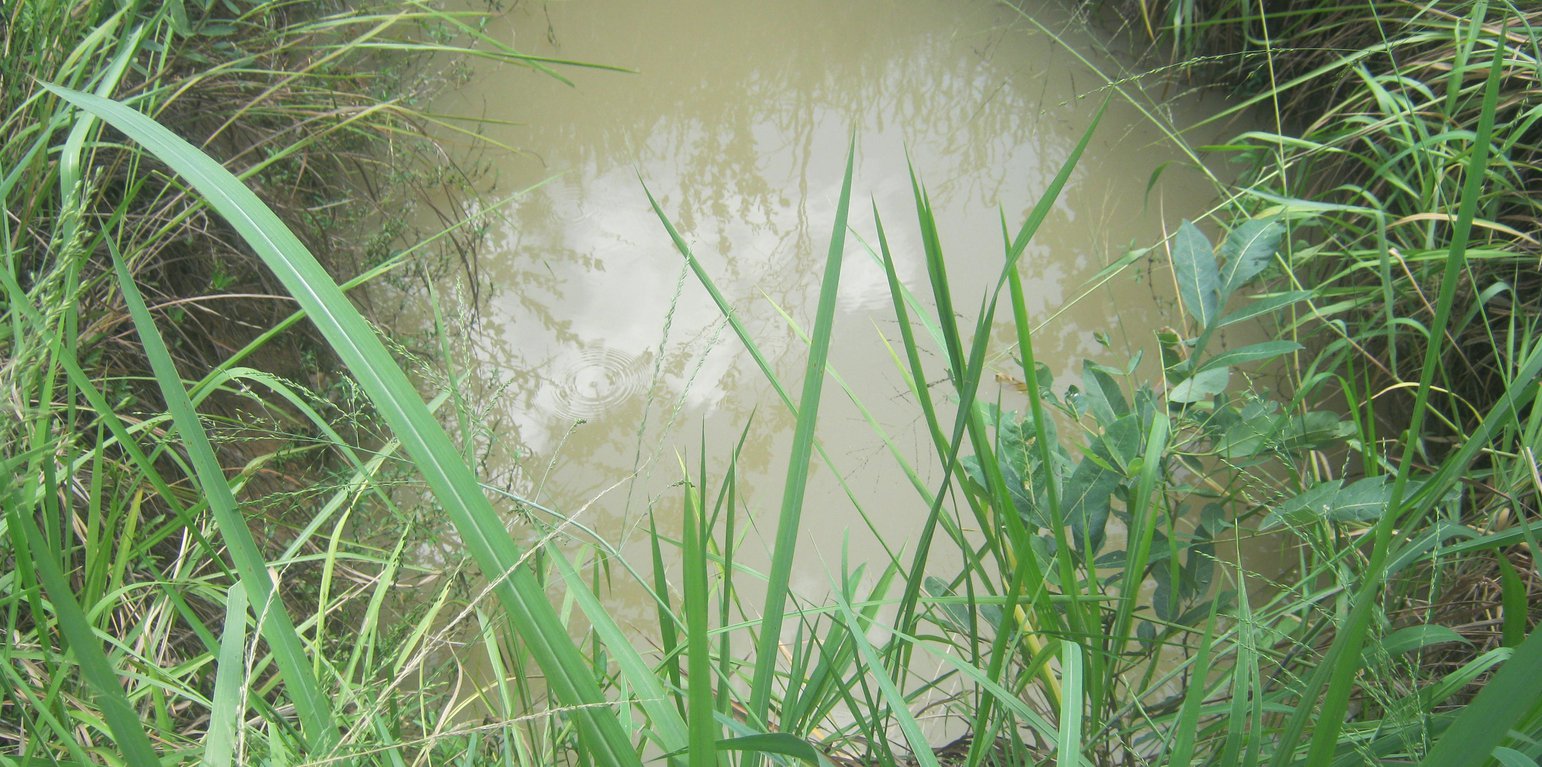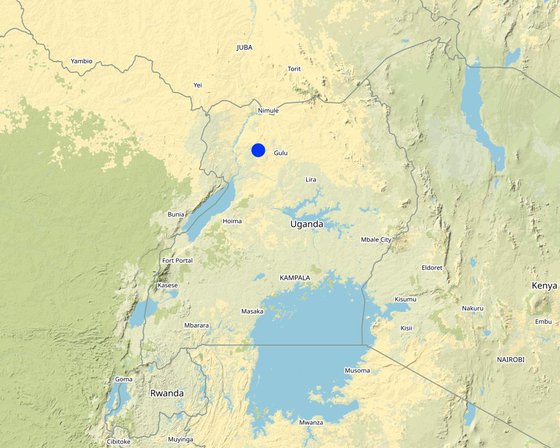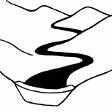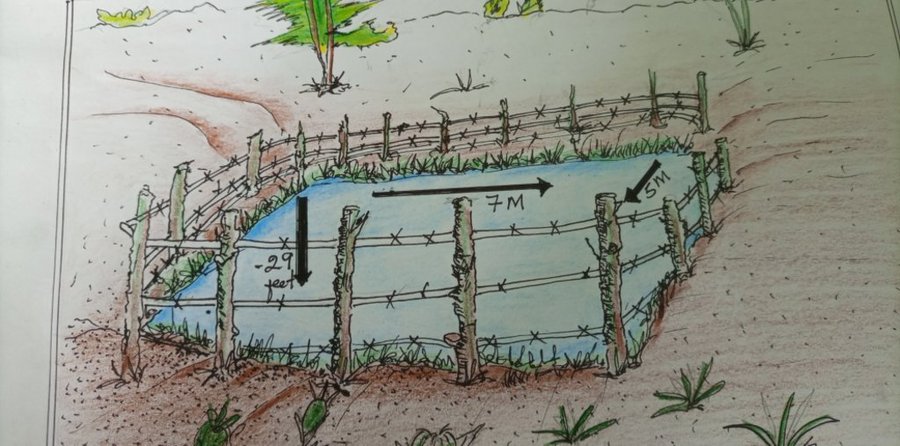



The spring ground water harvesting technology is one of the practices promoted by farmers in Northern Uganda with the aim of protecting and storing water which is used to refill the fish pond during dry season and also for fish production and household income both in the short, medium and long term.
Using hoes, spades, panga and labour, the water reservoir is dug at a length and width of 5*7 meters and a depth of 29 feet. Water fills the reservoir from ground water minor channels that drains at a specific point. Hence the reservoir fills up relatively fast. The reservoir site is well protected being fenced by barbed wire to avoid accidents from humans and animals who might fall into the reservoir.
Ridges are dug to prevent running external water from entering into the reservoir thus contaminating it. Grass grows around the cliff and around the reservoir to protect and compact the soil and prevent it from collapsing into the water, during dry season, water from reservoir is pumped into the fish pond. The water reservoir keeps water through out the year and fingerlings of 2 types or more of fish species kept in the fish pond. Sunlight can generally penetrate the pond waters to a depth of about 30-80 cm depending on the water level.
The fish species mostly kept include Tilapia, Nile Perch and wild fish. Once the technology is established the spring water reservior system requires only maintenance costs for removing weeds, feeding, restocking and slashing around spring water reservior. What is not liked about this technology is that it relies on a natural spring for its water supply. In case of drought survival of the fish is not guaranteed.

الموقع: Amuru Town Council, Northern Uganda., اوغندا
عدد مواقع تنفيذ التقنيةالتي تم تحليلها: موقع واحد
انتشار التقنية: يتم تطبيقها في نقاط محددة/ تتركز على مساحة صغيرة
تاريخ التنفيذ: 2012
نوع التقديم





| تحديد المدخلات | الوحدة | الكمية | التكاليف لكل وحدة (UGX) | إجمالي التكاليف لكل مدخل (UGX) | % من التكاليف التي يتحملها مستخدمو الأراضي |
| العمالة | |||||
| Labour | Manday | 30,0 | 5000,0 | 150000,0 | 100,0 |
| معدات | |||||
| Hoes | pieces | 3,0 | 10000,0 | 30000,0 | 100,0 |
| Spades | pieces | 3,0 | 10000,0 | 30000,0 | 100,0 |
| Panga | pieces | 3,0 | 10000,0 | 30000,0 | 100,0 |
| مواد البناء | |||||
| Barbed wire | roll | 1,0 | 100000,0 | 100000,0 | 100,0 |
| Wooden poles | pieces | 10,0 | 5000,0 | 50000,0 | 100,0 |
| غير ذلك | |||||
| Fingerlings | Animals | 50,0 | 1000,0 | 50000,0 | 100,0 |
| إجمالي تكاليف إنشاء التقنية | 440'000.0 | ||||
| تحديد المدخلات | الوحدة | الكمية | التكاليف لكل وحدة (UGX) | إجمالي التكاليف لكل مدخل (UGX) | % من التكاليف التي يتحملها مستخدمو الأراضي |
| العمالة | |||||
| Labour for cleaning | Manday | 30,0 | 5000,0 | 150000,0 | 100,0 |
| إجمالي تكاليف صيانة التقنية | 150'000.0 | ||||
Due to the water harvested and stored.
Due to additional water stored.
For fish production.
Expenses incurred only on the purchase fish feeds and maintenance of the reservoir.
From the sale of fish.
Only labour for cleaning around the reservoir and purchase of feeds.
الكمية قبل الإدارة المستدامة للأراضي: low
الكمية بعد الإدارة المستدامة للأراضي: high
Constant water supply in the fish pond to enhance production.
الكمية قبل الإدارة المستدامة للأراضي: low
الكمية بعد الإدارة المستدامة للأراضي: high
Water harvesting helps mitigating climate change impacts.
الكمية قبل الإدارة المستدامة للأراضي: low
الكمية بعد الإدارة المستدامة للأراضي: high
Ground water is harvested.
الكمية قبل الإدارة المستدامة للأراضي: high
الكمية بعد الإدارة المستدامة للأراضي: low
Due to the excess water stored.
الكمية قبل الإدارة المستدامة للأراضي: high
الكمية بعد الإدارة المستدامة للأراضي: low
Due to a more constant supply of available water.